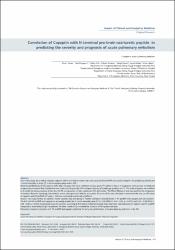| dc.contributor.author | Yavaşi, Özcan | |
| dc.contributor.author | Kayayurt, Kamil | |
| dc.contributor.author | Bilir, Özlem | |
| dc.contributor.author | Ersunan, Gökhan | |
| dc.contributor.author | Özyurt, Songül | |
| dc.contributor.author | Kırbaş, Aynur | |
| dc.contributor.author | Uğraş, Erhan | |
| dc.date.accessioned | 2022-08-09T11:10:14Z | |
| dc.date.available | 2022-08-09T11:10:14Z | |
| dc.date.issued | 2021 | en_US |
| dc.identifier.citation | Yavasi, O., Kayayurt, K., Bilir, O., Ersunan, G., Ozyurt, S., Kirbas, A. & Uğras, E. (2021). Correlation of Copeptin with N-terminal pro-brain natriuretic peptide in predicting the severity and prognosis of acute pulmonary embolism Copeptin in acute pulmonary embolism. Annals of Clinical and Analytical Medicine DOI: 10.4328/ACAM.20645 | en_US |
| dc.identifier.issn | 2667-663X | |
| dc.identifier.uri | file:///C:/Users/Nagihan%20Kaynak/Downloads/10.4328%E2%96%A102ACAM.20645.pdf | |
| dc.identifier.uri | https://hdl.handle.net/11436/6312 | |
| dc.description.abstract | Aim: In this study, we aimed to compare copeptin with N-terminal pro-brain natriuretic peptide (NT-proBNP) and cardiac troponin I for predicting severity and 3-month mortality in acute PE in the emergency department (ED).
Material and Methods: All ED patients older than 18 years who were confirmed to have acute PE within six hours of diagnostic work-up were enrolled and prospectively screened. Risk stratification was made according to the 2014 European Society of Cardiology guideline on PE. The study endpoints were defined as 3-month mortality, presence of non-low risk PE, and presence of right ventricular (RV) dysfunction. The Mann-Whitney Ll test was used for the comparison of medians. Receiver operating characteristic curves were generated and the area under the curve (AUC) was calculated to determine the best cut-off values of copeptin and NT-proBNP. A P value < 0.05 was considered statistically significant.
Results: The study enrolled 82 patients. Twelve patients who died during 3 months had higher concentrations of NT-proBNP and copeptin, but not troponin I. The AUCs of NT-proBNP and copeptin to accurately predict the 3-month mortality were 0.73 +/- 0.09 (95% CI, 0.62 - 0.82; p = 0.013) and 0.78 +/- 0.09 (95% CI, 0.68 - 0.86; p = 0.003), respectively. Low-risk patients, according to Pulmonary Embolism Severity Index, had lower concentrations of copeptin and NT-proBNP compared to intermediate-high risk patients. All three markers discriminated the presence of RV dysfunction truly.
Discussion: Copeptin correlates with NT-proBNP and appears beneficial for early risk stratification of acute pulmonary embolism in the ED. | en_US |
| dc.language.iso | eng | en_US |
| dc.publisher | Bayrakol Medical Publisher | en_US |
| dc.rights | info:eu-repo/semantics/openAccess | en_US |
| dc.subject | Acute pulmonary embolism | en_US |
| dc.subject | Copeptin | en_US |
| dc.subject | Emergency department | en_US |
| dc.subject | N-Terminal probrain natriuretic peptide | en_US |
| dc.subject | Troponin | en_US |
| dc.title | Correlation of Copeptin with N-terminal pro-brain natriuretic peptide in predicting the severity and prognosis of acute pulmonary embolism Copeptin in acute pulmonary embolism | en_US |
| dc.type | article | en_US |
| dc.contributor.department | RTEÜ, Tıp Fakültesi, Cerrahi Tıp Bilimleri Bölümü | en_US |
| dc.contributor.institutionauthor | Yavaşi, Özcan | |
| dc.contributor.institutionauthor | Bilir, Özlem | |
| dc.contributor.institutionauthor | Ersunan, Gökhan | |
| dc.contributor.institutionauthor | Özyurt, Songül | |
| dc.contributor.institutionauthor | Kırbaş, Aynur | |
| dc.identifier.doi | 10.4328/ACAM.20645 | en_US |
| dc.identifier.volume | 12 | en_US |
| dc.identifier.startpage | 472 | en_US |
| dc.identifier.endpage | 477 | en_US |
| dc.relation.journal | Annals of Clinical and Analytical Medicine | en_US |
| dc.relation.publicationcategory | Makale - Uluslararası Hakemli Dergi - Kurum Öğretim Elemanı | en_US |


















